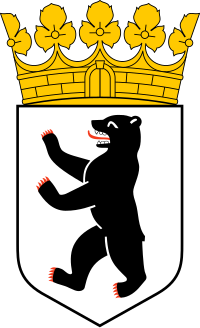| Berlin City state | |
|---|---|

| |
| Emblazoning | |
| Basic data | |
| Introduction: | 1954 |
| Legal basis: | Seal used ~1253 |
| Supporting Documents: | |
| Alterations: | 1935, 1954 |
| Coats of Arms of Berlins boroughs | |
| Sources | |
The coat of arms of Berlin is used by the Germancity state as well as the city itself, while Berlins various boroughs use their own emblems.
History edit
When in the 12th an 13th century more and more cities where funded, cities wanted official seals and later their personal coat of arms to seal official documents such as covenants or orders. A seal or coat of arms was usualy awarded by the sovereign. Berlin and Cölln (not the town today known as Cologne) as well as the surrounding cities of the Margraviate of Brandenburg were governed by the Brandenburg Margraves whose symbol was the red eagle. Before the bear in Berlins coat of arms appeared in the heraldic and sigillographic world, the red eagle was predominantly present in the seals and coats of arms of towns along the rivers Spree and Havel as well as in Berlin and Cölln.
The oldest conserved and known seal of Berlin is from 1253. It depicts, the Brandenburg Eagle spreading its wings in a clover shaped archway. The text on the seal is SIGILLVM DE BERLIN BVRGENSIVM (seal of berlins citizens). It supposedly has been the seal of Berlins first mayor Marsilius.
Berlin’s citizens however wanted their own symbol and coat of arms. How or why they choose the bear remains unknown. Most likely they though of Albrecht I., nicknamed “the bear”. He is considered to be the conqueror and founder of the Margraviate of Brandenburg. Another possibility is they etymologically decided on a “speaking” coat of arms since the first syllable of Berlin seems to be related to “Bär” (bear) onomatopoeticaly. In medieval times "speaking" coats of arms were a favorite. People tried to depict the cities name by use of symbols whose phonetics were similar to the cities name. However Berlin is not related to the German word "Bär". The name Berlin was created when slavic tribes settled in the area and means "place at the swamp" or "in a swampy area". Also a pearl would be more likely been choosen for the coat of arms since the Middle High German word for pearl is "berle". Middle High German was the spoken language of the time and pearls were indeed often used in a coat of arms.
| This page contains a translation of Wappen Berlins from de.wikipedia. |